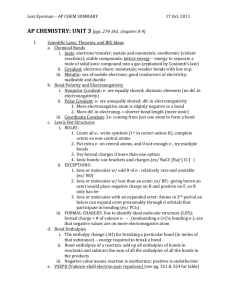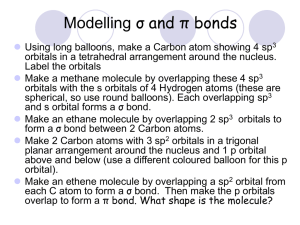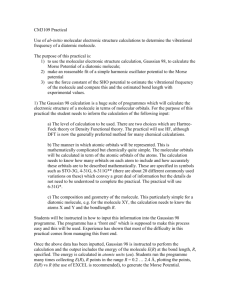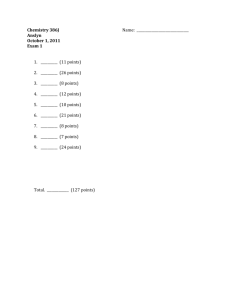Molecule Shape Bond Angle
advertisement
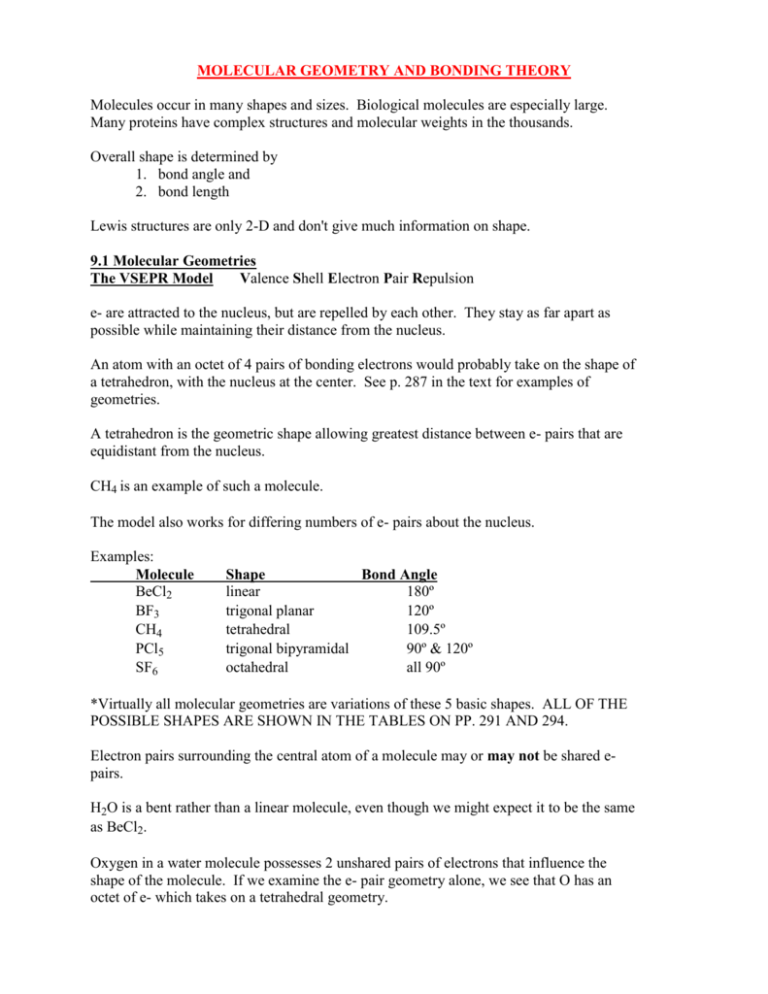
MOLECULAR GEOMETRY AND BONDING THEORY Molecules occur in many shapes and sizes. Biological molecules are especially large. Many proteins have complex structures and molecular weights in the thousands. Overall shape is determined by 1. bond angle and 2. bond length Lewis structures are only 2-D and don't give much information on shape. 9.1 Molecular Geometries The VSEPR Model Valence Shell Electron Pair Repulsion e- are attracted to the nucleus, but are repelled by each other. They stay as far apart as possible while maintaining their distance from the nucleus. An atom with an octet of 4 pairs of bonding electrons would probably take on the shape of a tetrahedron, with the nucleus at the center. See p. 287 in the text for examples of geometries. A tetrahedron is the geometric shape allowing greatest distance between e- pairs that are equidistant from the nucleus. CH4 is an example of such a molecule. The model also works for differing numbers of e- pairs about the nucleus. Examples: Molecule BeCl2 BF3 CH4 PCl5 SF6 Shape Bond Angle linear 180º trigonal planar 120º tetrahedral 109.5º trigonal bipyramidal 90º & 120º octahedral all 90º *Virtually all molecular geometries are variations of these 5 basic shapes. ALL OF THE POSSIBLE SHAPES ARE SHOWN IN THE TABLES ON PP. 291 AND 294. Electron pairs surrounding the central atom of a molecule may or may not be shared epairs. H2O is a bent rather than a linear molecule, even though we might expect it to be the same as BeCl2. Oxygen in a water molecule possesses 2 unshared pairs of electrons that influence the shape of the molecule. If we examine the e- pair geometry alone, we see that O has an octet of e- which takes on a tetrahedral geometry. We must be aware of unshared e- pairs before we can use the VSEPR model to predict molecular shape. 1. We take all e- pairs into account when describing e- pair geometry. 2. We describe only the atoms in the molecule when stating molecular shape. Tables 9.2 and 9.3 on pp. 291 and 294 in the text have several examples of how bond type, number of e- pairs and unshared e- pairs influence geometry and shape. Note that CH4, NH3, H2O and HF are all tetrahedral if we only look at e- pair geometry, however the shapes vary in their descriptions. The bond angles change slightly as unshared pairs appear. Unshared e- pairs take up more space than shared pairs which are held between 2 nuclear centers. So the bond angle in ammonia is only 107º rather than the predicted 109.5º associated with tetrahedral geometry. And likewise, the bond angle of a water molecule is affected even more and measures only 104.5º. SF4 is an interesting molecule. e- pr. geometry is trigonal bipyramidal, and S has 1 unbonded e- pair (making it an exception to the octet rule.) Please refer to Figure 9.5 on p. 293 for the following discussion: The one lone pair of unbonded electrons may occupy one of two positions: axial or equatorial (radial). 1. If the e- pr. is in an axial position, it will experience three 90º interactions with the pairs bonded in the equatorial positions. 2. If the unbonded pair is in an equatorial position, it will experience only two 90º interactions with the 2 bonded pairs in the axial positions. The unbonded pair is in reality found in this radial position because the repulsion of only 2 pairs at 90º is less than that of 3 pairs at 90º. Also, the lone unbonded e- pr. demonstrates the same effect on bond angles as seen in previous examples. The axial bond angle is 186º rather than the predicted 180º and the atoms in the equatorial positions are only 116º apart rather than the expected 120º. The VSEPR model can be used to predict just about any molecular geometry, whether for molecules obeying the octet rule or for exceptions. ** When applying the model, treat multiple bonds like single bonding e- prs. For example, CH2O has 4 bonds, 2 C-H bonds and a double bond C=O. The molecule is trigonal planar geometry. To use the model: 1. Count valence e- and draw the Lewis structure. 2. Determine the number of bonds (counting multiple bonds as singles) and unshared epairs . 3. Determine the e- pr. geometry for this number of bonds 2 = linear 3 = trig. planar 4 = tetrahedral 5 = trig. bipyramidal 6 = octahedral and put unshared pairs in positions that minimize e- pr. repulsions. 4. Describe the shape of the molecule in terms of the positions of the bonded atoms. (Unbonded pairs are NOT described as part of the molecular shape.) 9.2 Polarity of Molecules Molecular shape and bond polarity determine charge distribution in molecules. If the centers of + and - charge are not in the same place, the molecule is polar. The degree of polarity is measured by the molecule's dipole moment. Dipole moment (µ) is the product of the charge at either end of the molecule (Q) and the distance between the charges (r): µ = Qr. The unit of measure for dipole moment is the debye, D. D = 3.33 x 10-30 Cm (coulomb meters). Ex. The dipole moment of HCl is 1.03 D. Bond length, r = 1.36Å. Calculate Q: 1.03D x (3.33 x 10-30 Cm/D) = Q x 1.36 x 10-10m Q = 2.54 x 10-20C This value of Q is 16% of the charge of 1 e-. If HCl were ionic, the value would be 100%. As electronegativity difference decreases, so does the value of µ (in debyes). **A molecule may have polar bonds and yet be nonpolar overall because of its geometry. Ex. CO2 O = C = O The bonds are polar. Electron density is greater around O + + atoms, but the centers of both + and - charge are on carbon. Result, no overall molecular polarity and no dipole moment. This helps to explain many of carbon dioxide's physical properties. Because it is bent rather than linear, a water molecule is polar. Draw the water molecule and other examples here: *Unshared e- prs. can and often do contribute to polarity. 9.3 Covalent Bonding and Orbital Overlap Now we can tie the ideas of geometry and atomic orbitals together. When atoms share e-, valence orbitals of 2 atoms overlap, that is share the same region of space. The overlap balances the attraction for electrons of one atom to the nucleus of the other with the repulsions of the 2 nuclei and that of the e- for each other, producing the most stable orbital configuration. See p. 302 for an energy diagram of this process. The model is more difficult to explain with polyatomic molecules. For example, in CH4, carbon has 4 valence e-, 2s2 2p2. As we have seen, s and p sublevel electrons are of differing energies, yet the 4 C-H bonds in the molecule are exactly equal. This can be explained by the theory of hybridization (of the central atom). 9.4 Hybrid Orbitals Hybridization can be described as a mixing of an atom's valence shell orbitals. A 2s e- is "promoted" to an empty p orbital: _ _ _ _ 2s 2p 2s 2p Four hybrid orbitals are made from an s and 3 p orbitals resulting in four sp3 hybrids, all of equal energy. _ _ _ _ This hybridization results in tetrahedral orbitals with 109.5º angles. 2sp3 H2O has sp3 hybrid orbitals, too, but 2 of them contain unshared e- pairs. _ _ NH3 is also an sp3 hybrid molecule, but with one unshared e- pair and the other 3 bonded to H's. These are not pure sp3's since the bond angles are less than 109.5º. Several hybrid combinations are possible, and d orbitals may also get involved. Trigonal bipyramidal structures involve the hybridization of an s, 3 p's and a d orbital resulting in 5 equal energy hybrids: sp3d. Octahedral structures involve 2 d's: sp3d2. Table 9.5 on p. 307 gives the geometries associated with the various types of hybridization, and examples of molecules exhibiting these hybridizations. 9.5 Hybrid Orbitals and Multiple Bonds C2H4 ethylene is a planar molecule. All bond angles are 120º. For each C atom, the hybridization is sp2. One of the hybrid orbitals bonds to the other C and the other 2 bond each to a H. This leaves one unhybridized p orbital to form the second bond between the C's. When orbitals overlap end to end, e- density is symmetrically concentrated between the 2 nuclei. This is called a sigma (bond. There are nodes at the nuclei and two small areas of electron density outside the nuclei. s-s-overlap s-p overlap p-p overlap Sigma bonds are possible with: s-s orbital overlap, s-p overlap and p-p end-to-end overlap. It is also possible for p orbitals to overlap side-to-side. Such a molecular orbital is called a pi () bond. This is the type of bond formed by the unhybridized p orbitals of ethylene. In a bond, 2 areas of electron density form above and below the bond already in place. Each C atom goes through this imaginary process: Click here for a link to a nice picture of ethene’s orbitals. This model helps to explain some of ethylene's properties. H H H H \ / \ / C=C + Br2 ---> Br--C--C--Br Dibromoethane / \ / \ H H H H The bond is converted to 2 C-Br bonds. This is an example of an organic addition rxn. In acetylene (ethyne) C2H2, each C atom forms 2 sp hybrid orbitals. There is one bond to H and one to the other C. The remaining 2 unbonded p orbitals form 2 bonds, resulting in a triple bond between the 2 C atoms. Click here to see ethyne’s orbitals. Delocalized Orbitals So far, bonding e- have been localized, that is only associated with 2 atoms and basically confined between their nuclei, forming either or bonds. In some molecules, bonding e- can move freely over several atoms and are delocalized. Ex. Benzene C6H6 See p. 313 in the text for a good representation. Delocalized e- are typically found where resonance occurs between alternating single and double bonds, and one is not sure where to put the double bond(s) and so must draw resonance structures. (Image from Cornell.edu) In benzene, all C-C bonds angles are equal (120º), and the molecule is planar. Each C atom forms 3 sp2 hybrid orbitals. One bonds to a H, and the other 2 to C's. Image of benzene’s hybridized orbital and sigma bonds. The remaining p orbital (at right angles to the plane) forms bonds to the p orbitals of the C's on either side. These are delocalized e-, forming ring-like areas of e- density both above and below the plane of the molecule. Image 1 of resonating orbitals. Image 2 of resonating orbitals. The Lewis structure of benzene is abbreviated: A "corner" = a C atom. All H's are assumed to be present, but are not shown. A great many organic molecules contain such C ring structures. Examples: General Conclusions: 1. Every bonded pair of atoms shares 1 or more pairs of e-. At least 1 e- pr. forms a sigma bond. The appropriate set of hybrid orbitals used to form sigma bonds between an atoms and each of its neighbors is determined by observed geometry (Table 9.5) 2. Sigma bond e- are localized. 3. Additional bonds between atoms are bonds. 4. Pi bonds may be delocalized, extending over more than 2 bonded atoms. 9.6 Molecular Orbitals If you thought the model was weird up to this point, hang on to your electrons! Why do 2 atoms form a molecule? It must be energetically favorable. When atomic orbitals overlap and blend together, e- still exist in allowed E states or molecular orbitals. There are rules that govern how atomic orbitals can combine to form molecular orbitals: 1. When atomic orbitals combine, the number of molecular orbitals formed equals the number of contributing atomic orbitals. 2 atomic orbitals ---> 2 molecular orbitals. 2. Average E of these molecular orbitals is approximately equal to the average E of the atomic orbitals. However, the E of some individual molecular orbitals will be lower than the starting atomic orbitals while some will be higher. 3. The Pauli principle must be obeyed: 2 e- / orbital. 4. Atomic orbitals combine best with orbitals of similar E. 5. The greater the overlap of orbitals, the greater the stability. Ex. H2 overlaps two 1s orbitals forming 2 molecular orbitals: Atoms will only bond if there is an energetic advantage. In terms of this model, that means that we have more e- in bonding orbitals than in antibonding orbitals. So there is no tendency for He2 molecules to form. For an Li2 molecule, the bonding diagram looks the same as for H2. Even though Li has 1s2 e-, filled atomic shells and subshells do not contribute to the E advantage of bonding in molecule formation. WE only need to consider valence e- for bonding. Also, although all the alkali metals have ns1 configurations, H is the only one with a high enough bond dissociation E for it to be thought of as a diatomic molecule in most cases. (I know that all you Trekkies will be hugely disappointed to learn that "dilithium" only exists at very high temps and in the gaseous state, not in crystalline form at normal temps and pressures.) s and p orbital overlaps: see the diagram on p. 320 General Bonding E Level Diagram for Row 2 diatomic elements: *2p *2p 2p 2p 2p 2p s *2s 2s 2s Bonding diagram for N2. *2p 2p *2p 2p 2p 2p s *2s 2s 2s Bonding Diagram for O2. *2p *2p 2p 2p 2p 2p s *2s 2s 2s Bond Order can be calculated from such a diagram: B. O. = 1/2(# bonding e- - # antibonding e-) Ex. O2 4 bonding pairs, 2 antibonding pairs Bond Order - (8-4)/2 = 2 Oxygen has a double bond between atoms. N2 has a bond order of 3 and is exceptionally stable. Bond order = number of bonds in a Lewis diagram. Magnetism Unpaired e- in molecular ( or atomic) orbitals produces paramagnetism. Paramagnetic species can be drawn into a magnetic field, but are not themselves magnetic. If all e- are paired, the species will be diamagnetic, and is weakly repulsed by a magnetic field. Since O2 has 2 unpaired e-, (one in each of the 2p* orbitals) it is paramagnetic, and in fact liquid oxygen is attracted to a magnetic field. (See photo p. 325.) **Lewis diagrams do not show unpaired e-, where orbital diagrams do. Another example of paramagnetism can be found in the dye used to produce the green color on the back of U.S. paper currency, Cr2O3. The Cr+3 ion = [Ar]3d3 _ _ _ __ __ 3 unpaired e- makes the ion paramagnetic. Important characteristics of diatomic molecules: 1. dissociation E 2. bond length 3. ionization E: E needed to remove the highest E e- from the molecule. Diatomic ions are known to exist: N2+ and O2+. In lower rows of the table, diatomic molecules are not the most stable form of bonding for most elements except the halogens. Molecular bonds can also form between unlike atoms, but modified E diagrams must be used and the picture gets complicated very quickly. Structures of Nonmetallic Elements Halogens are all X2 in all phases. O2: short bond distance but the O=O Lewis structure doesn't account for the paramagnetism. O2 is one of the allotropes of elemental oxygen, the other is ozone, O3. O3 is a bent molecule with sigma bonds (sp2 hybrids) and a delocalized pi bond over the 3 atoms. Sulfur has several allotropes, the most common of which is S8, a yellow solid with sp3 tetrahedrons in 8 member rings. P4 is a trigonal pyramid. C exists as graphite (6 member flat rings) and diamond, a covalent network of interwoven tetrahedra- very strong bonds, very hard stuff.


